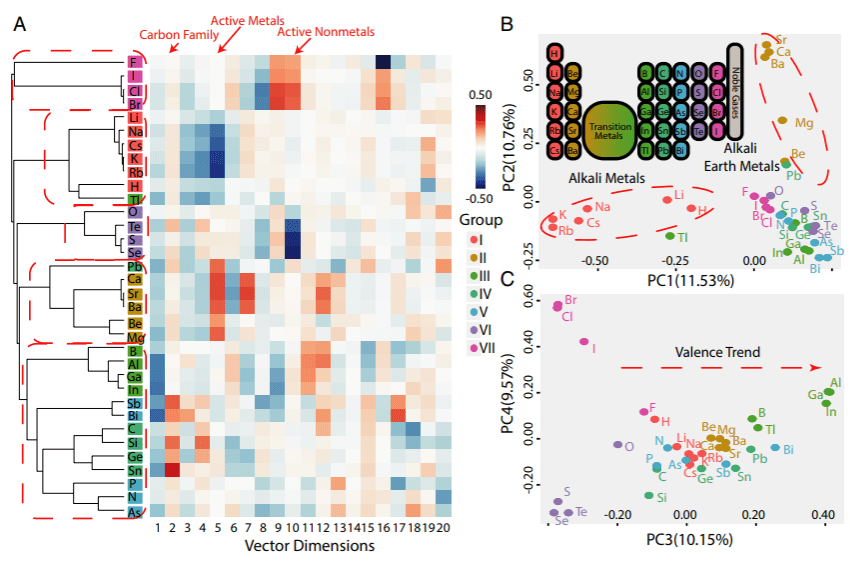A new artificial intelligence (AI) program developed at Stanford recreated the periodic table from scratch — and it only needed a couple of hours to do so.

Image credits Zhou et al., 2018, PNAS.
Running under the alluring name of Atom2Vec, the software learned to distinguish between different atoms starting from a database of chemical compounds. After it learned the basics, the researchers left Atom2Vec to its own devices. Using methods and processes related to those in the field of natural language processing — chiefly among them, the idea that the nature of words can be understood by looking at other words around it — the AI successfully clustered the elements by their chemical properties.
It only took Atom2Vec a couple of hours to perform the feat; roughly speaking, it re-created the periodic table of elements, one of the greatest achievements in chemistry. It took us hairless apes nearly a century of trial-and-error to do the same.
I’m you, but better
The Periodic Table of elements was initially conceived by Dmitri Mendeleev in the mid-19th century, well before many of the elements we know today had been discovered, and certainly before there was even an inkling of quantum mechanics and relativity lurking beyond the boundaries of classical physics. Mendeleev recognized that certain elements fell into groups with similar chemical features, and this established a periodic pattern (hence the name) to the elements as they went from lightweight elements like hydrogen and helium, to progressively heavier ones. In fact, Mendeleev could predict the very specific properties and features of, as yet, undiscovered elements due to blank spaces in his unfinished table. Many of these predictions turned out to be correct when the elements filling the blank spots were finally discovered.
We wanted to know whether an AI can be smart enough to discover the periodic table on its own, and our team showed that it can,” said study leader Shou-Cheng Zhang, the J. G. Jackson and C. J. Wood Professor of Physics at Stanford’s School of Humanities and Sciences.
Zhang’s team designed Atom2Vec starting from an AI platform (Word2Vec) that Google built to parse natural language. The software converts individual words into vectors (numerical codes). It then analyzes these vectors to estimate the probability of a particular word appearing in a text based on the presence of other words.
The word “king” for example is often accompanied by “queen”, and the words “man” and “woman” often appear together. Word2Vec works with these co-appearances and learns that, mathematically, “king = a queen minus a woman plus a man,” Zhang explains. Working along the same lines, the team fed Atom2Vec all known chemical compounds (such as NaCl, KCl, and so on) in lieu of text samples.
It worked surprisingly well. Even from this relatively tiny sample size, the program figured out that potassium (K) and sodium (Na) must be chemically-similar, as both bind to chlorine (Cl). Through a similar process, Atom2Vec established chemical relationships between all the species in the periodic table. It was so successful and fast in performing the task that Zhang hopes that in the future, researchers will use Atom2Vec to discover and design new materials.
Future plans
“For this project, the AI program was unsupervised, but you could imagine giving it a goal and directing it to find, for example, a material that is highly efficient at converting sunlight to energy,” he said.
As impressive as the achievement is, Zhang says it’s only the first step. The endgame is more ambitious — Zhang hopes to design a replacement for the Turing test, the golden standard for gauging machine intelligence. To pass the Turing test, a machine must be capable of responding to written questions in such a way that users won’t suspect they’re chatting with a machine; in other words, a machine will be considered as intelligent as a human if it seems human to us.
However, Zhang thinks the test is flawed, as it is too subjective.
“Humans are the product of evolution and our minds are cluttered with all sorts of irrationalities. For an AI to pass the Turing test, it would need to reproduce all of our human irrationalities,” he says. “That’s very difficult to do, and not a particularly good use of programmers’ time.”
He hopes to take the human factor out of the equation, by having machine intelligence try to discover new laws of nature. Nobody’s born educated, however, not even machines, so Zhang is first checking to see if AIs can reach of the most important discoveries we made without help. By recreating the periodic table, Atom2Vec has achieved this goal.
The team is now working on the second version of the AI. This one will focus on cracking a frustratingly-complex problem in medical research: it will try to design antibodies to attack the antigens of cancer cells. Such a breakthrough would offer us a new and very powerful weapon against cancer. Currently, we treat the disease with immunotherapy, which relies on such antibodies already produced by the body; however, our bodies can produce over 10 million unique antibodies, Zhang says, by mixing and matching between some 50 separate genes.
“If we can map these building block genes onto a mathematical vector, then we can organize all antibodies into something similar to a periodic table,” Zhang says.
“Then, if you discover that one antibody is effective against an antigen but is toxic, you can look within the same family for another antibody that is just as effective but less toxic.”
The paper “Atom2Vec: Learning atoms for materials discovery,” has been published in the journal PNAS.


